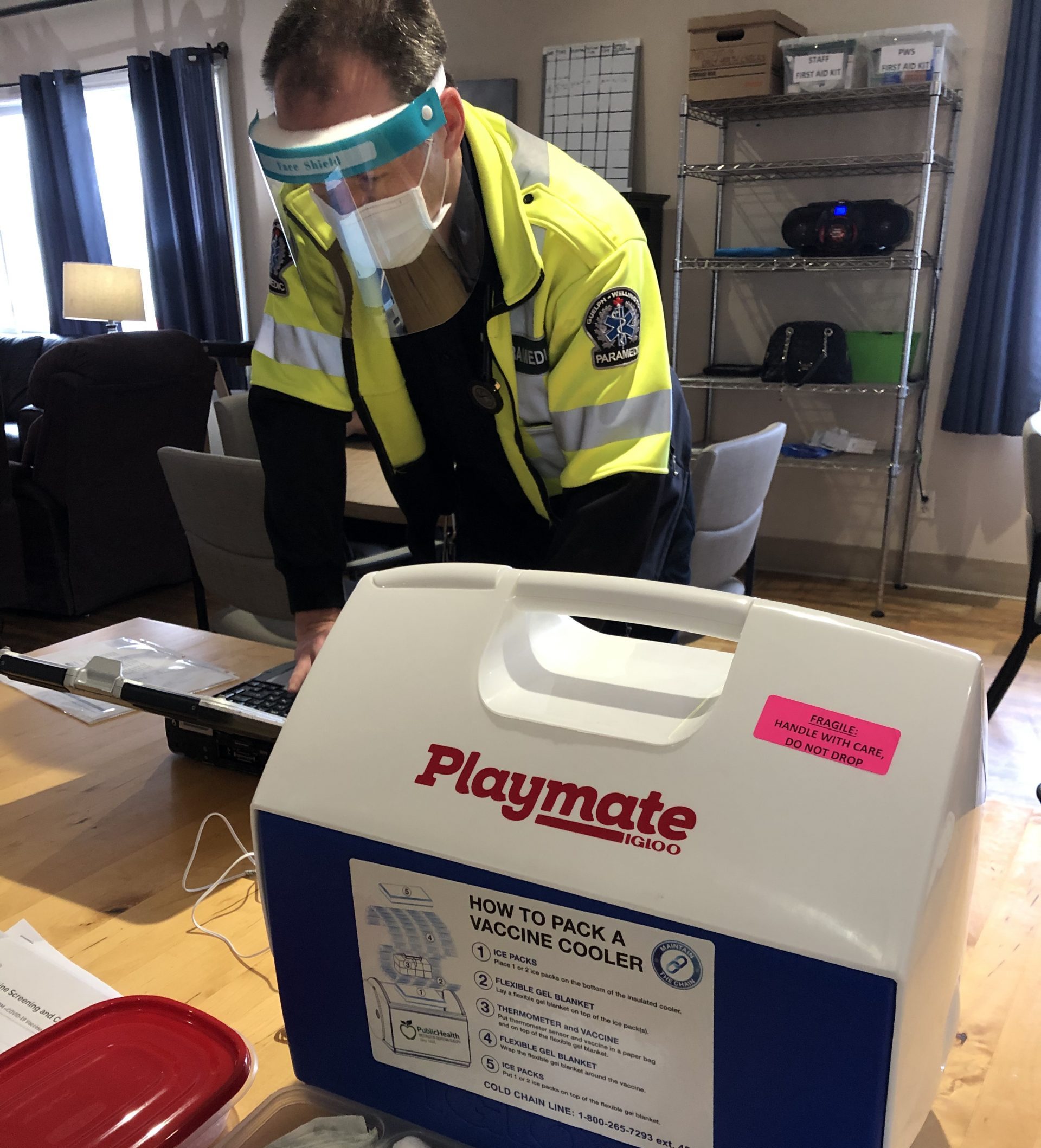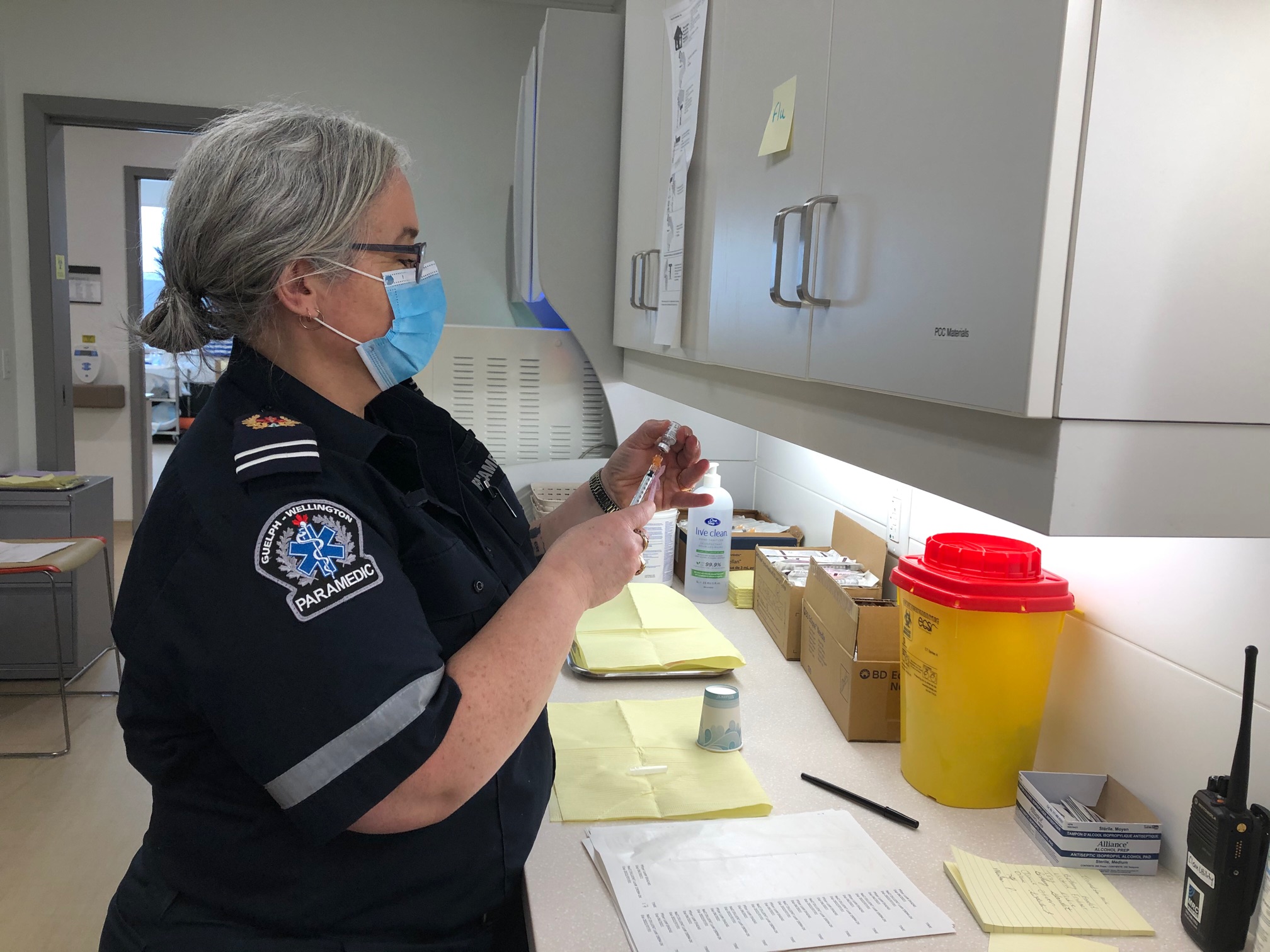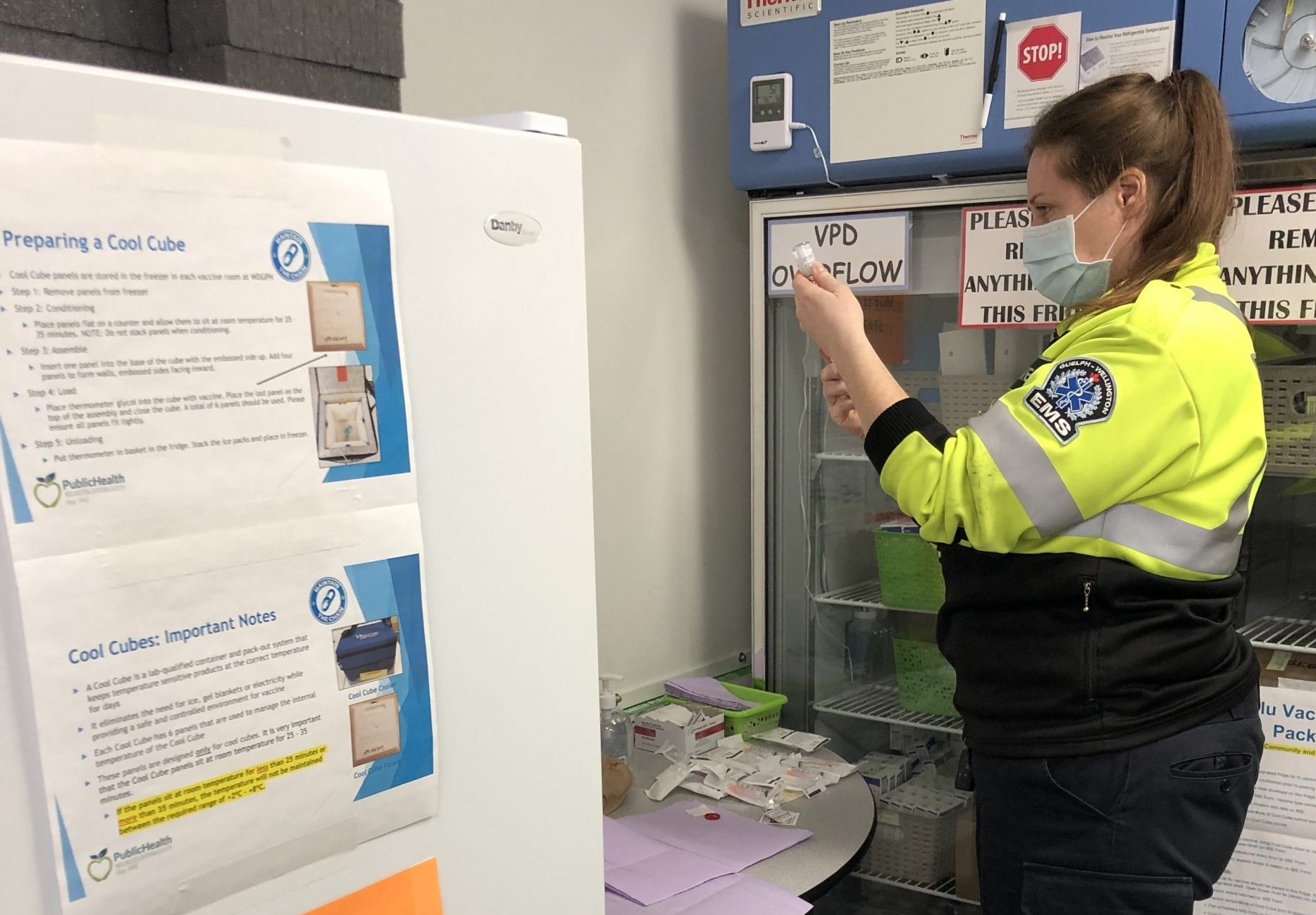WELLINGTON COUNTY – To be a paramedic is to quickly respond, both to emergency medical calls and an ever-evolving job description.
Pre-pandemic, it’s unlikely Guelph-Wellington Paramedic Service (GWPS) paramedics would’ve imagined stepping out from their mobile emergency rooms and into a frontline battle against a global health crisis.
But that’s exactly where they are, lacing up their boots every day to do their part to bring about an end to the COVID-19 pandemic.
Testing and vaccinations
In April 2020, local paramedics trained in swabbing for the COVID-19 virus, teaming up with Wellington-Dufferin-Guelph Public Health (WDGPH) to complete testing at long-term care and retirement homes, and congregate settings like group homes and homeless shelters.
To date, paramedics have completed 5,600 swabs for the virus.
Earlier this year, paramedics were trained in administering COVID-19 vaccinations, once again teaming up with public health to get vaccines into the arms of the most vulnerable in long-term care homes.
Within 40 days, all eligible patients within the county’s long-term care and retirement settings were fully vaccinated with first and second doses.
Now, the service’s 75 vaccination-trained paramedics are also giving jabs at vaccination clinics throughout the county, supplementing public health staff where needed. They’ll be returning to the Fergus sportsplex on June 1.
Paramedics also began vaccinating people, referred to the service by WDGPH, in-home at the end of March. To date, paramedics have administered 180 vaccine doses in-home, according to GWPS deputy chief Leanne Swantko.

Guelph Wellington Paramedic Service paramedic Stephen Foster inputs patient information into a computer behind a cooler containing vials of COVID-19 vaccine. Submitted photo
Vaccinations were a natural next step for paramedics, who are already well-acquainted with administering drugs via intra-muscular injections — as is the case with vaccine doses.
What isn’t so familiar is having to orchestrate a rush against the clock to get needles in arms across the county before the fragile doses expire after six hours.
“The clock has started as soon as you puncture the vial,” said Rebecca Leis.
She is a road supervisor in addition to being a lead for COVID-19 response, coordinating training and the logistics of getting vaccines into arms across the county.
‘Organized and calculated’
A list of patients arrives from public health and Leis sits down with a map to plot out when and where crews will go for the day.
Crews will go as far as Puslinch before heading north to Mount Forest on some days, Leis said.
“It’s very organized and calculated and it has to be a very concise plan before we start our day.”
On vaccination days – anywhere from one to three days a week – paramedics head to a secure vaccine room to collect vials of Moderna and Pfizer, syringes, coolers and thermometers.
“We will draw it up there, we will usually take another frozen vial with us to drop later midday and we’ll pack it all in coolers,” Leis explained.
A single vial will provide enough for 10 doses of vaccine, with an occasional eleventh pulled. Another frozen vial, which takes an hour to thaw, will cover another 10 vaccinations in the afternoon.
Doses are split up among two crews of two paramedics who can accomplish between 20 to 22 vaccinations a day.
“When I signed up for this job, I never thought I would be doing this as part of my every day,” Leis said.
“There are certain people we’re meeting that we’re the first person they’ve seen in a year … we get to see them before their own grandchildren, you know, so it’s pretty humbling and it gives us definitely a sense of purpose that’s new for us.”
Many of the paramedics swabbing and administering vaccinations sign up to take shifts on their days off. Leis spends much of her “off-time” coordinating logistics for the in-home service.

Guelph-Wellington Paramedic Service advanced care paramedic Amy Benn draws a dose from a vial of COVID-19 vaccine. Submitted photo
“There’s never been a day where I have to say to them, ‘Sorry, we can’t vaccinate you today because we don’t have anybody’; there’s always somebody that’s willing to step up,” Leis said of the effort.
Out of the vials so far, there hasn’t been a single wasted vaccine — a point deputy chief Swantko is proud to mention.
COVID+ monitoring
From January to the end of March this year, the service ran a program monitoring patients with COVID-19 before funding expired at the end of March.
But within a couple days, Swantko says the service was back up and running (by popular demand), tapping into some of the $6.1 million provided by the Ministry of Long-Term Care for the service’s Community Paramedicine for Long-Term Care Program.
Patients with COVID-19 who have moderate to severe symptoms are referred by WDGPH to have their vital signs monitored remotely by the paramedic service for dramatic changes which could signal a worsening case of COVID-19.
“For us to be able to take on this part, it’s more about really supporting the community,” Swantko said, speaking of how swamped public health has become with vaccinations, swabbing and contact tracing.
Those with stronger symptoms and those who have pre-existing health conditions are monitored differently from those with milder symptoms.
Whereas those who are coping well will get a verbal check-in, more acute patients will receive a visit from community paramedics who will suit up in protective gear, enter a person’s home and set up equipment which transmits a person’s vital signs over an internet connection to paramedics who can view the data remotely.
Swantko said there’s a lot of anxiety accompanying a diagnosis of COVID-19, and remote monitoring can provide peace of mind.
“That said we have absolutely had situations where the remote monitoring has picked up on low oxygen levels in the blood and that has resulted in that patient being transported to the emergency department,” she said.
Patients check their vital signs throughout the day and night, and if, for instance, the amount of oxygen saturating a person’s blood drops below an acceptable level, paramedics will get an alert and check in.
“So, if we’re able to see that ahead of that transitioning into worse condition, it significantly impacts on the patient themselves … we’re connecting with them daily to see how they’re doing and to offer support and to offer some reassurance,” she said.
As of May 25, there are 20 patients in the COVID+ monitoring program with around 180 having used the service, according to Swantko.
Hospital transfers
Paramedics have also been stepping up to assist in the shuffling of patients between the province’s hospitals, coordinated by the not-for-profit ambulance service Ornge, to create capacity in intensive care units (ICU).
Between Jan. 1 and May 16 this year, 2,179 patients have been transported, according to Orgne spokesperson Joshua McNamara.
Of those, 1,263 transfers have been completed by paramedic services, with GWPS having transferred seven patients as of May 16.
Swantko voiced her admiration for the service’s staff, saying, “they have given of themselves personally to take on additional training, increasing their skills and working on their scheduled days off to safeguard our communities.”




